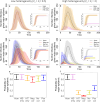This is a preprint.
Heterogeneity in and correlation between host transmissibility and susceptibility can greatly impact epidemic dynamics
- PMID: 40385430
- PMCID: PMC12083616
- DOI: 10.1101/2024.12.10.24318805
Heterogeneity in and correlation between host transmissibility and susceptibility can greatly impact epidemic dynamics
Update in
-
Heterogeneity in and correlation between host transmissibility and susceptibility can greatly impact epidemic dynamics.J Theor Biol. 2025 Aug 21;611:112186. doi: 10.1016/j.jtbi.2025.112186. Epub 2025 Jun 17. J Theor Biol. 2025. PMID: 40553770
Abstract
While it is well established that host heterogeneity in transmission and host heterogeneity in susceptibility each individually impact disease dynamics in characteristic ways, it is generally unknown how disease dynamics are impacted when both types of heterogeneity are simultaneously present. Here we explore this question. We first conducted a systematic review of published studies from which we determined that the effects of correlations have been drastically understudied. We then filled in the knowledge gaps by developing and analyzing a stochastic, individual-based SIR model that includes both heterogeneity in transmission and susceptibility and flexibly allows for positive or negative correlations between transmissibility and susceptibility. We found that in comparison to the uncorrelated case, positive correlations result in major epidemics that are larger, faster, and more likely, whereas negative correlations result in major epidemics that are smaller and less likely. We additionally found that, counter to the conventional wisdom that heterogeneity in susceptibility always reduces outbreak size, heterogeneity in susceptibility can lead to major epidemics that are larger and more likely than the homogeneous case when correlations between transmissibility and susceptibility are positive, but this effect only arises at small to moderate . Moreover, positive correlations can frequently lead to major epidemics even with subcritical . To illustrate the potential importance of heterogeneity and correlations, we developed an SEIR model to describe mpox disease dynamics in New York City, demonstrating that the dynamics of a 2022 outbreak can be reasonably well explained by the presence of positive correlations between susceptibility and transmissibility. Ultimately, we show that correlations between transmissibility and susceptibility profoundly impact disease dynamics.
Keywords: correlation; heterogeneity in susceptibility; heterogeneity in transmission; infectious disease dynamics; mpox.
Figures












Similar articles
-
Heterogeneity in and correlation between host transmissibility and susceptibility can greatly impact epidemic dynamics.J Theor Biol. 2025 Aug 21;611:112186. doi: 10.1016/j.jtbi.2025.112186. Epub 2025 Jun 17. J Theor Biol. 2025. PMID: 40553770
-
Immunogenicity and seroefficacy of pneumococcal conjugate vaccines: a systematic review and network meta-analysis.Health Technol Assess. 2024 Jul;28(34):1-109. doi: 10.3310/YWHA3079. Health Technol Assess. 2024. PMID: 39046101 Free PMC article.
-
Short-Term Memory Impairment.2024 Jun 8. In: StatPearls [Internet]. Treasure Island (FL): StatPearls Publishing; 2025 Jan–. 2024 Jun 8. In: StatPearls [Internet]. Treasure Island (FL): StatPearls Publishing; 2025 Jan–. PMID: 31424720 Free Books & Documents.
-
The Black Book of Psychotropic Dosing and Monitoring.Psychopharmacol Bull. 2024 Jul 8;54(3):8-59. Psychopharmacol Bull. 2024. PMID: 38993656 Free PMC article. Review.
-
Behavioral interventions to reduce risk for sexual transmission of HIV among men who have sex with men.Cochrane Database Syst Rev. 2008 Jul 16;(3):CD001230. doi: 10.1002/14651858.CD001230.pub2. Cochrane Database Syst Rev. 2008. PMID: 18646068
References
-
- Aguas R., Corder R.M., King J.G., Goncalves G., Ferreira M.U., Gomes M.G.M., 2020. Herd immunity thresholds for SARS-CoV-2 estimated from unfolding epidemics. medRxiv.
-
- Allard A., Moore C., Scarpino S.V., Althouse B.M., Hébert-Dufresne L., 2023. The role of directionality, heterogeneity, and correlations in epidemic risk and spread. SIAM Review 65, 471–492.
-
- Anderson R.M., May R.M., 1991. Infectious diseases of humans: dynamics and control. Cambridge University Press.
Publication types
Grants and funding
LinkOut - more resources
Full Text Sources
